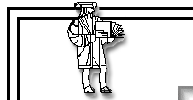 |
 |
|
Cast ForgeriesSand and Clay Mold Castings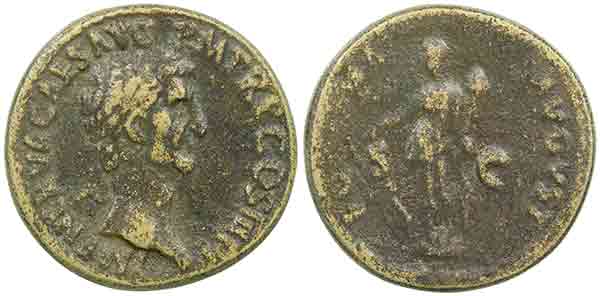
Sand casts are generally poor quality castings intended only for the tourist market as even novice collectors can learn to easily spot them. A mold is constructed in two parts using sand combined with binding agent. The bottom of the coin is impressed in one part, a spacer placed allowing the parts to be separated, then the top of the coin is impressed into the top part of the mold. The coin is removed and a sprue channel is created through which molten metal can be introduced. The mold is them rejoined. This nine minute video shows a ring copied by the sand cast method, although the video say it is a clay mold process it appears a sand clay mix was used so I consider this sand casting. There are several characteristics objects made in sand molds will exhibit. 
The joint between the mold halves is normally not perfect, leaving an impression of the joint often as a slight ridge around the edge of the casting. Metal may also leak into the joint creating a different type of ridge known as a flashing. Together these are known as casting seams and may go part or all the way around casting. A sprue which filled the sprue channel will be attached and must be cut off. 
Here we see a filed edge where a casting seam or sprue were removed from this coin. Some forgers will further smooth the edge and may "worry" it to hide file marks, but will never make it look like the natural edge of a genuine ancient coin. There are types of genuine ancient coins with filed edges due to their flan production methods, with Ptolemaic bronzes the most commonly encountered. Most ancient coins were struck on cast flans and while casting seams on them seldom go around the edge of the final coins, and are usually obliterated in striking, there are exceptions. Roman Republican Aes Grave are cast rather than struck so nearly always have a casting seam, and some later Republican bronzes struck on cast flans commonly have one. Before condemning a coin for a marks or an edge seam one must be certain that is not normal for that exact type. 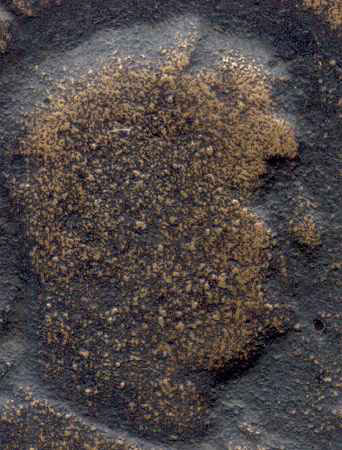
The texture of sand grains will usually be replicated on the fake's surface, as seen on this sand cast Balbinus sestertius. The size of the sand grains varies so you may need magnification to see them, but their presence is the best indicator of sand casting. Even very fine sand is too course to capture the very fine details of a coin, so sand cast fakes have relatively poor details when compared to genuine ancient coins. Even worn ancient coins preserve some sharpness in protected areas, but sand castings have over all weak details. Sand casting was an invented of the Sui Dynasty in the 6th century AD China and was not known to the ancient people in the Mediterranean region which is why a sand cast Roman or Greek coin will always be a modern fake. Once invented in China, nearly all Chinese coins from the 6th to 19th century are sand cast, and the Chinese become masters at it. Because of all the limitations, sand cast are never used to make forgeries intended to fool knowledgeable collectors and dealers. They are widely used to make fakes to be sold into the tourist market where the buyer has no experience with what a genuine ancient coin would look like. Clay Mold CastingClay mold casting is closely related to sand casting but uses the much finer medium of clay which can capture finer details. A difference is that the mold halves will stick together must be broken to remove the casting. As the clay is lightly fired in the process it usually cannot be reused. While more labor intensive than sand casting and capturing more details, it shares some of the problems with sand casts. This three and a half minute YouTube video shows a simply clay mold casting, differing slightly from how a coin would be cast as the object copied here slides easily out of the mold while a mold for a coin requires the mold cut to remove the coin, then rejoined leaving a joint during casting. Clay mold casting was used by ancient Greeks and Romans counterfeiters and thousands of broken terracotta coin molds have been found across the Mediterranean basin. Few ancient coins are ever identified as ancient clay mold counterfeits, yet the number of molds found shows they were made in large numbers. Patina can mask the surfaces of a bronze coin, and most clay more counterfeits are missed because of this. Permanent Mold CastingOlder permanent molds were made of metal, while newer ones are sometimes made of other materials including rubber. They have fairly smooth surfaces and can capture finer details than sand molds without sand grain impressions on the final surfaces. They tend to have a poorer seal between the mold halves requiring extra work to remove mold seams and sprue points This four and a half minute YouTube video shows metal toy soldiers being cast in modern rubber molds. Metal molds were used cold and conduct heat quickly causing rapidly cool the molten metal. Unless the metal was heated considerably above its melting point there was a danger of it solidifying before the mold was completely filled. Newer rubber molds cannot take that high of temperatures, so the castings are of special very low melting point alloys. Neither is suitable for high melting point metals such as the silver, gold or copper genuine ancient coins are made of, so to get the look of those metals other alloys are used them plated to get the correct look. 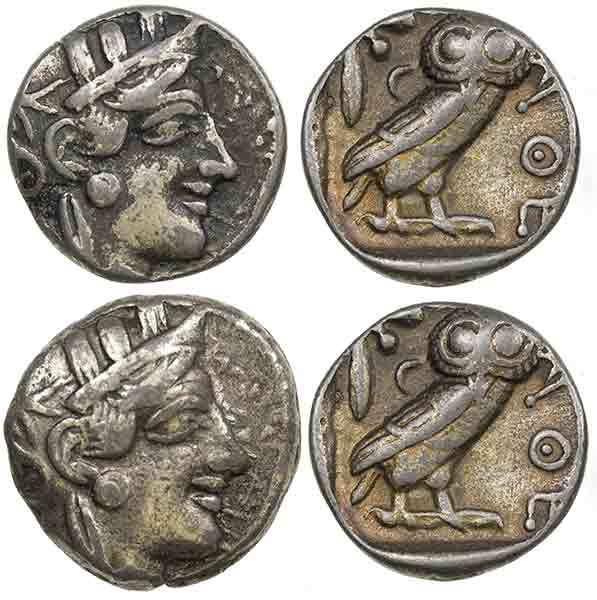
Permanent molds produce many nearly identical coins as with these replica Athenian tetradrachms which differ only in their surface coloration. These were cast in a grey base metal then plated with a silvery metal, probably either rhodium or chrome. Two ancient coins this identical in both their details and outline are highly suspect and warrant closer examination. Rapid production but difficulty making the coins look ancient makes permanent molds the preferred mass production method for tourist and museum gift store replicas. These Athenian tetradrachm would never pass as genuine to anyone with any level of experience, but were included in famouse coin reproduction sets sold in museum stores, or given out as promotional items during the 1960's and 70's. They are common and I several times a year I am approached by non-collectors who have one and think it is genuine. Lost Wax CastingsLost wax casting is a two-step process. Modern forgers make latex or silicon rubber molds of a genuine coin, which can capture very fine details making them the more dangerous of cast fakes. These rubber molds are used to cast a wax copy of the coin and since each mold is a permanent mold, many wax copies of the coin can be made. Prior to the 19th century invention of rubber other methods were used to mold the waxes, but no forger is likely to use such methods today. The wax copy is suspended in a metal tube then encased in a plaster like material known as investment. Once hardened and dried the investment mold is placed in a high temperature kiln where the wax burns out leaving a cavity with the details of the original coin. Many waxes can be in each investment mold allowing for high volume castings Molten metal is introduced via a sprue channel while the investment mold is still hot from the kiln. Quality can be improved through pressure casting, usually by spinning the mold using centrifugal force to inject the molten metal, but steam can also be used to apply pressure. The mold is allowed to cool only enough for the metal to solidify, then placed in cold water causing the investment break up releasing the casting. This two and a half minute YouTube video show jewelry casting is identical to what a forger of ancient coins could do. An advantage of lost wax casting is while wax made in the rubber mold will have a casting seam, that seam is easily removed from wax. The investment mold has no joint so no there is no casting seam on the final metal casting, just a small sprue leaving a small sprue point that is easily worked over and hidden. Other technical difficulties must be overcome. Rubber is impervious to air so small air bubbles can become trapped in the rubbers before vulcanizing. These fill with wax at the wax injection stage resulting in raised bumps on the wax, which in turn result in the raised bumps on the final metal casting. Air bubbles can also be trapped during wax injection forming holes in the wax which are reproduced as small holes (more depressed areas) on the final casting. Known as casting bubbles, these usually have the round form of bubbles either on or into the finished casting. 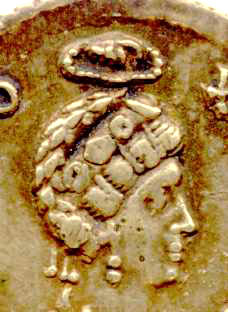
This example shows numerous casting bubbles. Raised ones can be seen as a cluster in front of the chin, a large one in the upper left field, and several small ones around the eye and bridge of the nose. Depressed ones are visible on her cheek and several places in her hair. Die deterioration can cause various bumps and depressions on genuine ancient coins but they are seldom as round as are casting bubbles. Weight control due to shrinkage at three stages is also a problem for lost wax casting. Once the mold is made, vulcanizing the rubber results in minor shrinkage. Hot wax injected into rubber mold shrinks slightly as it cools resulting in the investment mold cavity slightly smaller than the original coin. Hot metal is injected also shrinks slightly as it cools in the investment mold. Each stage of shrinkage is minor but the cumulative effect results in a finished coin usually about 18% lower weight than the original coin. Measures can be taken to reduce weight reduction but can be difficult. 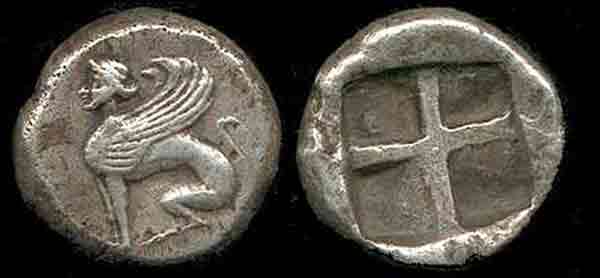
Many ancient coins were struck to relatively exact weight standards with less than 18% variation. A genuine Chios didrachm of this type would weight 7.8 grams give or take no more than about 0.3 grams. At 6.12 grams this specimen is 21% below the standard weight, and 18% below the lowest expected weight of 7.5 grams, indicating it is most likely a lost wax cast fake. This coin will be discussed in greater detail in the examples section. 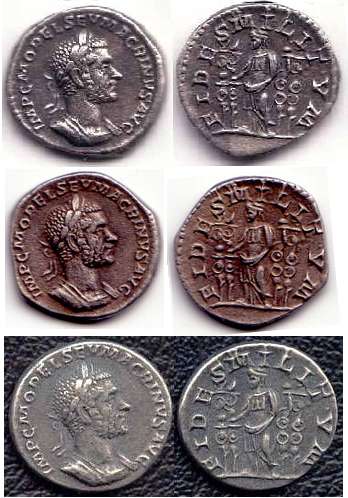
All examples from one mold will be very similar if not identical. At the wax stage minor modifications such cutting down or building up the edges to change an outline are possible as wax is easy to work with. These three Macrinus denarii were sold on eBay by the "Toronto Group" forger from Toronto, between about 2000 and 2004. Other than they have minor differences in their outlines they are far too identical to be genuine ancient coins (two maybe, three is impossible). General Problems Of All Cast FakesNo molding process is perfect and some of the smallest details cannot capture by any molding process. The finest details resulting from die striking are flow lines created as metal flows into the designs during striking. Too small to see even normal magnification, they affect how a coin reflects light, giving a coin its luster. One does expect to have flow lines on a paginated but they will be preserved at least in protected spaces on silver and gold coins even if highly worn. Look for luster inside of letters, along a bust truncation, inside hair lines, or anywhere where the designs meet the fields at a sharp angle. All castings are devoid of any genuine luster and once you understand exactly what to look for you will know if it is there or not. The one thing that can remove all lustre from a genuine ancient silver or gold coin is harsh cleaning or corrosion so one must be careful with such coins. Many ancient coins have thin flan cracks or splits, easily visible to the unaided eye or with low magnification. A flan crack should show on both sides of a coin, passing completely through the coin and be visible on the edge of the coin. A flan split should come to a very fine point at it's apex. No casting method can capture the structure of a crack, or the ultra-fine point of at the end of a split. Only surface look of a crack will be visible and that fine point at the end of a split will be slightly rounded. 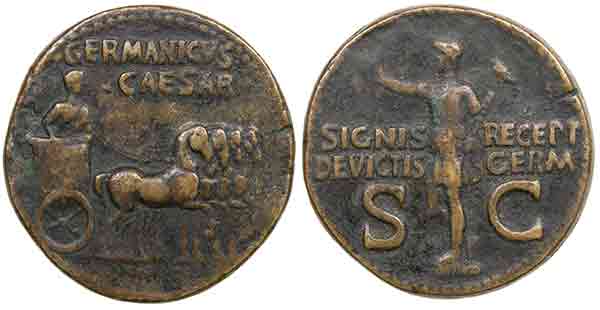
This Germanicus bronze has a small flan crack going through from the reverse to the obverse at about 2 o'clock. As it is visible on both sides it must go completely through the coin. 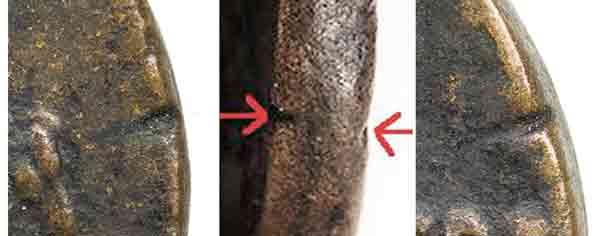
Here we can see the crack appears to be only the surface impression of a crack, but were the edge was worked to remove evidence of casting all traces of the crack disappear showing there is now internal crack going through this coin. This coin is a lost wax casting made in the 18th or 19th century before the invention of rubber molds, which is why the details are a little softer than one expects on a good modern lost wax cast using rubber molds. Microscopic surface textures are created as a coin is manufactured, and are different on a cast surface than a die struck coin, especially on a coin that has naturally aged in the ground for 2000 years. You would need a very powerful microscope to see these structures, possibly an electron microscope but you can see is how light reflects off them and how a casting is devoid of any true luster. The surfaces also feel different where genuine ancient coin will have a surface that feels slightly resistant, while castings usually feel slightly slippery, often described as feeling soapy. Any coin that feels slippery or soapy should be very closely examined for other signs of casting. Most cast fakes have multiple problems. At a Chicago International Coin Fair about 2010 David Vagi showed me a large group of Roman silver denarii which he had already decided were mostly cast fakes with some genuine coins mixed in. He came to that conclusion having noted one characteristic of cast coins I discuss above. I examined them for a different characteristic also discussed above. Not only did we both come to the same conclusion, but with near perfect agreement as to which were genuine and which fake. These were some of the best lost wax fakes I had seen, yet two experienced people easily spotted them as fakes looking at different characteristics. Casting can never produce a perfect fakeIn recent years large numbers of cast fakes have come from Bulgaria, including the group described above. Ilya Prokopov and Eugeni Paunov have been recording and writing about them. Their books are available inexpensively from SP-P Publishing house. The images are not the best but these books are still useful. Next page: Electrotype fakes Copyright © 2016 R & T Enterprises Ltd. |